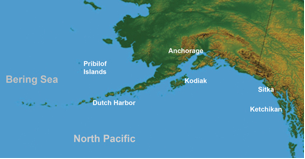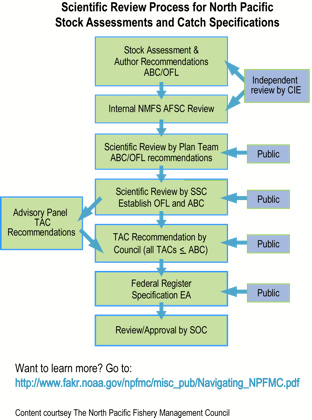| SUMMARY
Fisheries are an important part of the North Pacific and Bering Sea ecosystems. These ecosystems are recognized as vibrant, healthy and sustainable as a result of a science-based approach to fisheries management. A science-based approach to ecosystem management is constantly evolving in a collaborative effort to balance social, economic, biologic and market needs. Often referred to as a “precautionary approach” to management, the basic framework is based on sound scientific analysis applied proactively to ensure the sustainability of the fishery resources and associated ecosystems for the benefit of current and future generations. Fisheries managers, working with industry and coastal communities, employ a dynamic “adaptive management” approach that includes community-based and rights-based (“catch share”) allocative measures to protect the ecosystem from overfishing and to increase habitat protection. |
 The North Pacific and Bering Sea provide more then 5 billion pounds of fish and shellfish annually. These waters are home to 26 species of marine mammals, 38 species of seabirds and billions of other organisms that make up one of the world’s most prolific marine ecosystems.
The North Pacific and Bering Sea provide more then 5 billion pounds of fish and shellfish annually. These waters are home to 26 species of marine mammals, 38 species of seabirds and billions of other organisms that make up one of the world’s most prolific marine ecosystems.
|
Ecosystem-based fisheries management that is precautionary,
science-driven and adaptive to changing conditions
| Wild fish stocks are a dynamic resource, subject to swings in abundance due to changes in climate, feed and other factors. Because of the wide variability within the marine ecosystem, fisheries managers and the industry work together to set harvest limits based on the best available science to protect the resource.
Key habitat areas are closed to protect the broader ocean ecosystem … the size of these closures is now more than five times the size of the entire US National Park System. Limited access and catch-share quota systems have been developed to end the often destructive and dangerous “race for fish,” and these systems are now recognized as a key strategy to prevent over-fishing. Once every five years, the North Pacific Fishery Management Council conducts a complete review of its Essential Fish Habitat (EFH) program, and other conservation and management measures to minimize potential adverse impacts from fishing. On an annual basis there is also a Stock Assessment and Fisheries Evaluation (SAFE) process that looks at a broad set of Ecosystem Considerations prior to the Council setting annual harvest rates and limits. This all takes place through an open, transparent public process. In addition to public input, the Council utilizes a Scientific and Statistical Committee (SSC) and industry Advisory Panel (AP) to assess the impacts of each proposed management measure. This approach to sustainable management has evolved over time, and is now considered a role model for fisheries managers throughout the world. For more information visit us at: www.marineconservationalliance.org |
Watch the video. Dr. David Fluharty discusses the impact of adaptive management on the marine ecosystem and the Alaska pollock fishery.
|
Maintenance


